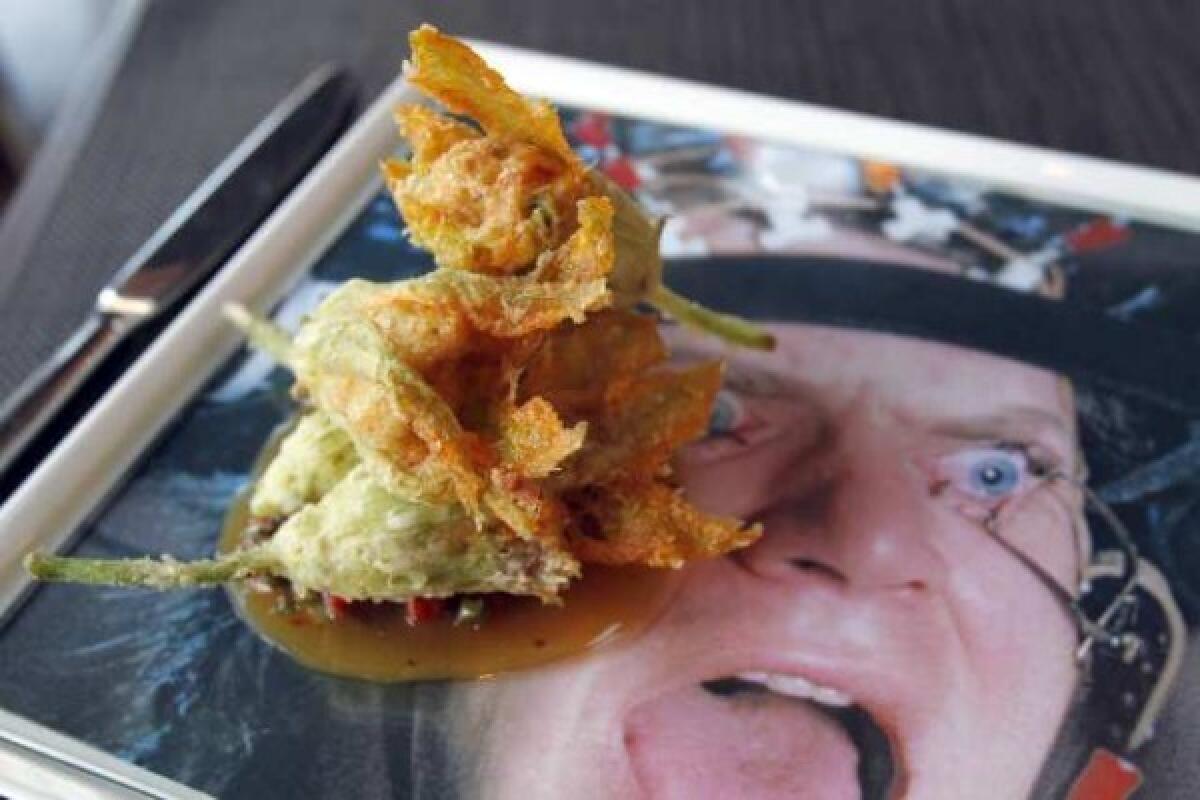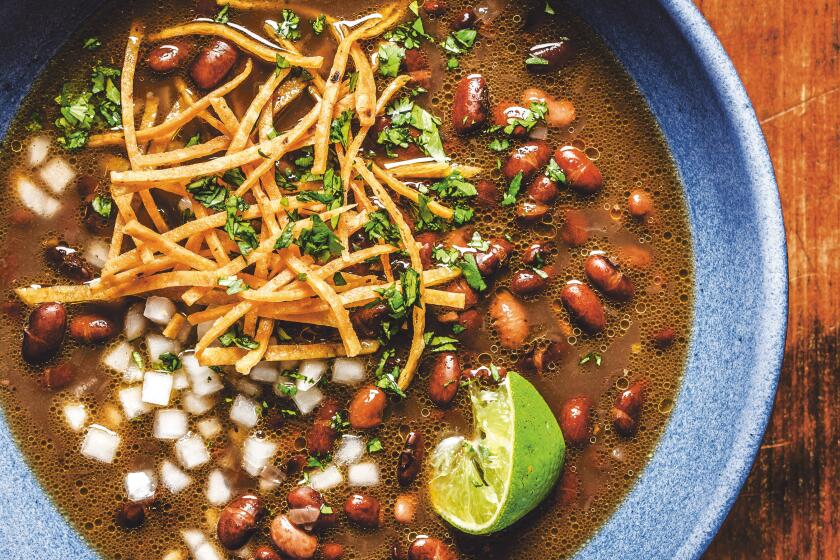The Review: Playa

On the plate, a wide-eyed Malcolm McDowell stares up at me from beneath his bowler. It’s a bit disconcerting to find the violent figure from “A Clockwork Orange” sharing space with seared day-boat scallops at Playa. On another plate, squash blossom tempura is framed by another scene from the brilliant (and creepy) film.
John Sedlar is pushing the envelope again.
Sedlar has never been able to do just food. He has the impulses of a conceptual artist, except his medium is food. He’s the Jenny Holzer of the culinary world: At his downtown restaurant Rivera he sometimes stencils the plates with evocative words written in spices.
It’s not just about words and images though. Where other chefs struggle to present a plate that’s as pleasing to the eye as the palate, Sedlar seems to effortlessly turn out dramatic, eye-catching compositions that taste as exciting as they look. This is a place where the dishes have such a visual snap-crackle that I want to take out crayons and draw them.
At Playa, the menu focuses more on inventive bites centered on freshly made tortillas or masa dough. The vibe is more casual and relaxed, the pace a bit faster than at Rivera, where the range of more complex dishes is broader. The food at Playa is just as beguiling, taking you on a trip through Sedlar’s taste memory of the urban Latin landscape.
The restaurant, which moved into the old Grace space on Beverly Boulevard in mid-February, is surprising and playful. Here are Sedlar’s notes from the menu: “Incendiary chiles. Static velocity. Shimmering waves. Fractured white light.... Briny air. Racing traffic. Wet sand.” Think of those words as his inspiration board.
Designed by architect Osvaldo Maiozzi and interior designer Deborah Gregory, the restaurant captures that spirit of fun with an open plan, high ceilings and a wall of rusted steel. Lights that look like albino sea urchins dangle overhead. Banquettes topped with mirrors, French bistro-style, line a wall. There’s a communal table too, close to the action in the kitchen.
What’s to eat? Wonderfully inventive maize cakes, i.e., handmade tortillas. That means the tortillas florales embedded with organic rose petals that are so popular at Rivera. I love the chewy stone-ground texture of the tortillas against velvety avocado butter. But also try the one topped with cauliflower prepared several ways. It looks like a futuristic landscape with oven-dried, caramelized and hibiscus-pickled florets poking up from the surface, wreathed in a subtle curry espuma or foam. Every bite is delightful.
On another maize cake, prawn tentacles point straight up and tiny beads of frozen mustard ice cream are strewn on top of the shrimp like loose pearls. The Bombay-inspired version is terrific too, featuring big cubes of pork belly confit with mango pickle and chile-lime jicama. Try it with the Spice Trade cocktail, a delirious mix of double-aged rum, galangal, kaffir lime tincture and bitter lemon soda.
Julian Cox, who created the cocktails at Rivera, is also working his magic here. He mixes it up, changing his list frequently, and is always willing to offer a bespoke cocktail to suit your taste or desire. Notable: An Oaxacan in the Clouds made with a strong dose of mezcal and flavored with espelette pepper and crispy sage with roasted cherry tomatoes on a skewer across the top. On the other hand, sometimes the flavors get away from him. The Bloody Mary I tried at brunch was incendiary and rough, too wild for that hour of the morning.
With an eclectic menu like Playa’s, wines by the glass may be the way to go. The wine list also has a fine choice of Spanish and Portuguese whites, and plenty of Tempranillos along with other reds from Latin countries, including Mexico. Now’s your chance to expand your drinking horizons.
Try a Rioja or a Ribera del Duero with the earthy tamale chipotle. The masa dough is laced with a delicious wild mushroom duxelles. Sliced filet mignon is laid out at one end, along with a satiny béarnaise spiked with the smoky chile. Baja surf clams, chiles and queso ranchero are steamed inside a giant clam to make one of the most comforting dishes I know.
Don’t be scared off by the idea of huitlacoche (corn fungus) sauce with an ethereal fresh corn custard and queso cotija. Such a delicate, refined dish, combining two aspects of sacred corn. Another of my favorite dishes is flor de calabaza tempura, perfectly fried squash blossoms stuffed with chunks of firm Spanish bacalao (salt cod) and served with a fiery chorizo jus, capers and olives. Is it Spanish? Is it Mexican, or Mediterranean? Who knows and who cares? It’s just good.
As you’ve probably guessed by now, Playa isn’t your typical Mexican or even Latin restaurant. Trained as a French chef, Sedlar takes different strands from cuisines and weaves them together in his own inestimable way to create something new. I hesitate to call it fusion. It’s pure Sedlar.
Occasionally a dish disappoints, such as the overly rich piquillos rellenos, peppers stuffed with Gruyère and chorizo and punctuated with raisins. Or the chile-rubbed pork tenderloin (one of the most boring cuts ever) in salsa verde — they’re just not up to the standard the rest of the menu sets.
But don’t miss the inexpensive sides. I could eat an entire bowl of the kale with posole and pickled ancho chiles.
Desserts stand in the wings waiting to get onstage but can’t really compete with the stellar lineup of savory dishes. The almondine ice cream served with a small square of blue corn gâteau demands to be tasted and marveled over. And just about anybody would be happy with the pineapple bread pudding with coconut sorbet.
Sedlar’s dishes may sound intellectual when described, but on the plate, their flavors are gutsy and compelling. No doubt about it, he’s out there on the far fringes of experimentation. But with experience comes maturity. Before opening Rivera, Sedlar took almost a decade off from restaurants. It’s given him the space and time to be more thoughtful and reflective about food and his cooking. He’s someone who looks at food through a very particular lens, trying to put it in context with the rest of the world, bringing in politics, edgy art and environmental concerns.
And yet none of that seems to get in the way of his cooking. When he’s on — and these days he’s very on — dishes just ring loud and true as a gong.
Playa
Rating: Two and a half stars Rating is based on food, service and ambience, with price taken into account in relation to quality. ****: Outstanding on every level. ***: Excellent. **: Very good. *: Good. No star: Poor to satisfactory.
Location: 7360 Beverly Blvd. (between La Brea and Martel avenues), Los Angeles, (323) 933-5300, https://www.playarivera.com.
Price: Small plates, $8 to $16; larger plates, $19 to $29; sides, $6; desserts, $8 to $10.
Details: Open 5:30 p.m. to midnight Sunday to Wednesday, 5:30 p.m. to 1 a.m. Thursday to Saturday, also, 10 a.m. to 2 p.m. Saturday and Sunday. Corkage fee, $20. Valet parking, $6.
More to Read
Eat your way across L.A.
Get our weekly Tasting Notes newsletter for reviews, news and more.
You may occasionally receive promotional content from the Los Angeles Times.










